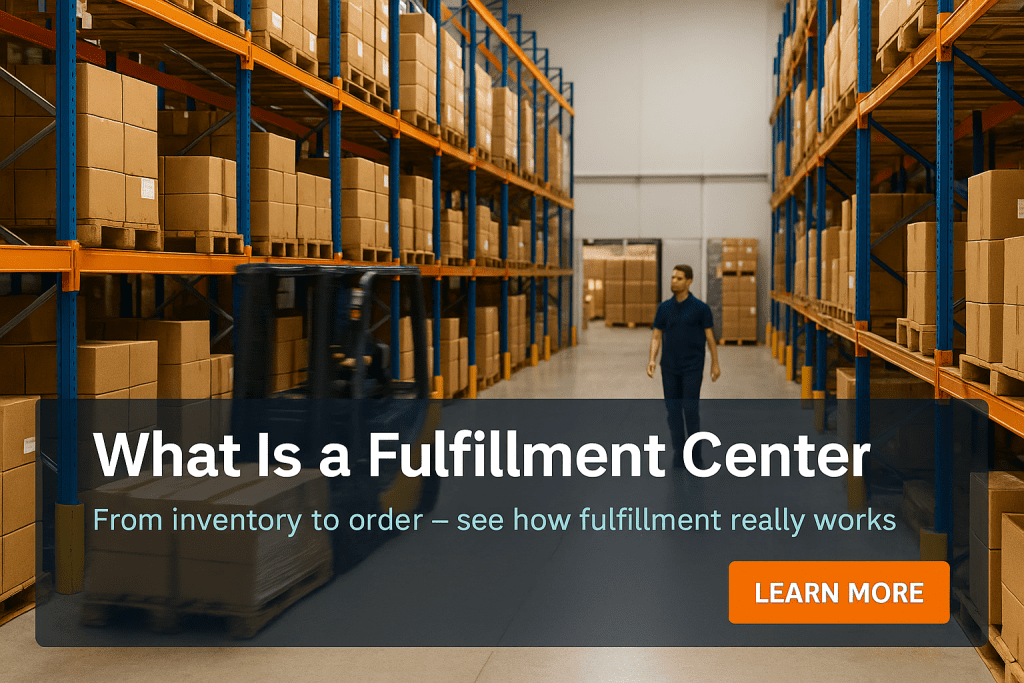Author: Jason Martin
Reviewed by: Supply Chain Solutions Lead
Last updated: October 9, 2025
Executive TLDR
A fulfillment center receives, stores, picks, packs, and ships your orders so customers get what they bought on time.
Clean product data, labeled locations, and simple workflows drive speed and accuracy.
For consumables, FEFO with lot and expiry tracking protects freshness and compliance.
A central Midwest hub can deliver to most U.S. customers in 1 to 3 days by ground.
Standardized packaging and smart carrier choices protect margin on small parcels.
Questions about launching or upgrading fulfillment — Contact Product Fulfillment Solutions
Table of contents
What a fulfillment center actually does
Core workflows from inbound to doorstep
Why location and speed matter
Controls for dated and regulated goods
Costs you can control today
When to outsource to a 3PL
Why Product Fulfillment Solutions
FAQ
What a fulfillment center actually does
A fulfillment center is the operational backbone of ecommerce. It receives your inventory, stores it in labeled locations, picks items for each order, packs them in the right materials, and ships them with carrier labels and tracking. Good centers also handle returns, kitting, and light assembly. The goal is simple, ship fast, ship right, keep costs predictable.
Core workflows from inbound to doorstep
Receiving and putaway
Inbound arrives with an ASN so carton contents match what the system expects.
Items are counted, checked for damage, and labeled if needed.
Stock moves to assigned bins with clear IDs so pickers find it fast.
For clean dock flow and staging, see warehousing and storage solutions.
Storage and inventory control
Locations are named and labeled. Fast movers live near pack to reduce travel.
Cycle counts and location audits keep inventory accurate.
For consumables, lot and expiry are captured at receiving.
Picking
Orders drop to the floor in a standard path. Batch picking for single-line orders and waves or clusters for multi-line orders.
Scanning at pick cuts mispicks, especially for look-alike SKUs.
Learn how this ties into 3PL fulfillment.
Packing
A simple packaging matrix right sizes boxes or mailers by product family to reduce DIM charges and damage.
Inserts are added when they help, instructions, care, or a reorder path.
A second scan at pack confirms contents before label creation.
See pick and pack services.
Shipping
Labels are created after the final scan at pack.
Rates are shopped by weight, zone, and promised time.
Tracking flows back to your store or channels.
Explore discounted shipping rates.
Returns
Returns are routed away from outbound. Items are inspected then restocked, quarantined, or scrapped with photos and a short checklist.
Why location and speed matter
Where inventory sits decides how fast and affordably you deliver. A central U.S. hub in Cincinnati gives 1 to 3 day ground reach to most buyers. That means happier customers without paying for air. With smart slotting and clear cut-offs, you can keep same day handling for orders before your daily deadline. For visibility and alerts, use real-time information.
Controls for dated and regulated goods
If you sell supplements, vitamins, cosmetics, or other health and wellness products, accuracy is everything.
FEFO, first expiry first out, ensures freshness.
Lot and expiry capture at receiving enables clean recalls and audits.
Location flags mark bins that require lot picking.
Kitting sheets include component lots for sets and subscription boxes.
See health and wellness fulfillment services and kitting assembly services.
Costs you can control today
Right sized packaging lowers DIM charges on small parcels and reduces damage.
Standard labels and ASNs cut rework and refusals at receiving.
Slotting by velocity reduces walking and labor costs.
Centralized inventory avoids duplicated safety stock across many nodes.
When retail or marketplace orders come online, keep chargebacks low with EDI solutions and connections.
When to outsource to a 3PL
Consider a 3PL when order volume outgrows your space, when SLAs slip, or when you need multichannel workflows without hiring a full team. A solid partner provides systems, labor, and carrier relationships so you focus on product and growth. Start with a small pilot, then scale in waves. Explore ecommerce fulfillment services.
Why Product Fulfillment Solutions
Central U.S. hub in Cincinnati for 1 to 3 day ground to most customers.
Barcode first receiving aligned to your ASN for predictable dock to stock speed.
FEFO and lot or expiry control tailored for consumables.
Pick and pack standards that protect accuracy and margin.
Kitting and light assembly for promos and subscription boxes.
Small parcel optimization with smart rate shopping and right size packaging.
Retail and marketplace readiness with simple label templates and EDI.
FAQ
Is a fulfillment center the same as a warehouse
Not exactly. A warehouse stores inventory. A fulfillment center also picks, packs, ships, and handles returns with clear SLAs.
How fast should orders move
Most brands target same day handling for orders before cut off. With a central hub, most buyers still get 1 to 3 day ground.
Do I need lot and expiry tracking
If you sell ingestibles or regulated items, yes. Capture lot and expiry at receiving and pick by FEFO.
How big should my packaging matrix be
Start simple, a few right sized mailers and cartons that cover the catalog. Expand only when tests show savings or fewer damages.
What is the fastest way to start with a 3PL
Run a scoped pilot of top movers. Map SKUs to barcodes, confirm label placement, send a small clean inbound, and measure accuracy and speed for a week.

